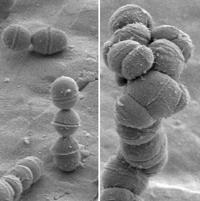Group B streptococcus, or Streptococcus agalactiae, is responsible for infections of the bovine mammary gland (mastitis), and can also cause serious diseases in humans (e.g. pneumonia, meningitis, septicemia), particularly in neonates. Researchers at INRA and the Institut Pasteur demonstrated the key role played by a molecule known as antigen B, located on the surface of the bacterium. Their research has determined this molecule’s involvement in controlling bacterial growth, and provides a promising outlook for the fight against these infections. The findings were published today (June 14, 2012) in PLoS Pathogens.
Press release
Paris, june 14, 2012

In 1934, the American bacteriologist, Rebecca Lancefield, developed an immunological technique for identifying streptococci, based on the presence of a complex sugar, or polysaccharide, in the bacterial cell wall. In Streptococcus agalactiae, this polysaccharide, known as antigen B, had no known biological function.
Researchers from the INRA center in Jouy-en-Josas and the Institut Pasteur have now demonstrated the major biological role played by this molecule exposed on the bacterial surface and universally used in clinical bacteriology identification tests since its discovery nearly 80 years ago.
The wall is an integral component of the bacterial cell; reactions take place here that control cell growth and division, which are the target of many antibiotics. These highly complex phenomena involve multiple molecular interactions, which require a high level of coordination in terms of location and activity. The researchers showed that antigen B is essential for the correct progress of bacterial cell growth, division and morphogenesis. The photographs below illustrate the cell defects observed in the absence of antigen B.
The outlook in the fight against streptococcal infections
Surface polysaccharides similar to antigen B are present on the surface of many of the streptococci that cause a range of human and animal infections. The synthesis of surface polysaccharides therefore offers a potential target for the development of new, anti-infective molecules.
© Inra / Thierry Meylheuc and Michel-Yves Mistou
S. agalactiae with (left) or without antigen B (right)
Référence
E. Caliot et al. Role of the Group B Antigen of Streptococcus agalactiae: a Peptidoglycan-anchored Polysaccharide Involved in Cell Wall Biogenesis. PLoS Pathogens, June 14, 2012
Science contact
Michel-Yves MISTOU
mistou@jouy.inra.fr - +33 (0)1 34 65 27 71
MICALIS “Food and Digestive Microbiology for Human Health”
Scientific division “Microbiology and the Food Chain”
Jouy-en-Josas INRA center
Contacts
Institut Pasteur Press Office
Nadine Peyrolo / +33 (0)1 45 68 81 47
Sabine D'Andréa / +33 (0)1 44 38 92 17
presse@pasteur.fr




